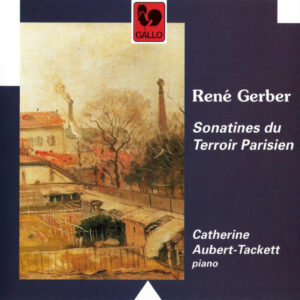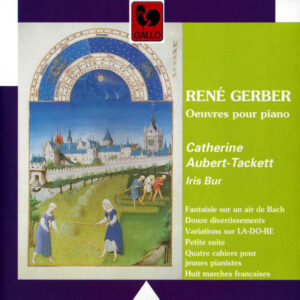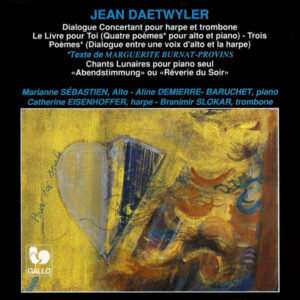Extraits / Excerpts
CAROLINE BOISSIER-BUTINI – EDOARDO TORBIANELLI, PIANOFORTE
First World Recording
Award: 5 Diapason
Caroline BOISSIER-BUTINI : Piano Sonata No. 1 – Caprice sur l’air d’une ballade écossaise (Roy’s Wife of Aldivalloch) – Sonatine No. 1, dédiée à Melle Valérie Boissier – Variations sur deux airs languedociens – Piano Sonata No. 2 – Caprice et variations sur un air bohémien.
Edoardo Torbianelli, Pianoforte Broadwood.
The sonatas
When the musical oeuvre of Caroline Boissier-Butini was rediscovered in 2002, we were amazed to find that it included piano sonatas. During her lifetime, this form was in France almost exclusively represented by German musicians living there or those influenced by German musical culture. Since Geneva had been annexed by France in 1798 (until 1814), it can be assumed that the young Caroline Butini was marked by French culture in these formative years of her musical education (although studies on this are lacking). Did the young musician engage with a form that was barely cultivated in France as a protest?
In any case, for a musician of the time, a sonata in the repertoire or catalogue of works signifies a means of achieving one’s own artistic personality, in contrast to a ”Concerto”, which served principally to highlight the virtuosity of its interpreters. Caroline Boissier-Butini must have been aware of the increasing differentiation in France and elsewhere between popular and more serious instrumental music, particularly chamber music, because in the 18105 she turned away from composition at least twice to spend a year studying ”the old masters” and thus consolidate her compositional foundation.This indicates that she was aiming for her musical work to be more than a flash in the pan; she certainly wanted to acquire a musical profile of her own, as indicated by her plan to publish her works – specifically, her sonatas – in 1818 in Paris.
In terms of the form, a comparison of definitions in German and French musical dictionaries provides the key to understanding the differences between the two countries.
Heinrich Koch writes in his 1802 definition of the sonata: “it is thus not sufficient in the sonata that the main theme, or the theme of each section, conveys the expression of a particular sentiment, but also in order, to receive the material to continue this sentiment, it must also be presented together with the associated secondary ideas in new and interesting turns and links, so that pursuing the whole captures the attention, and the expression of the sentiment in all its modifications gains interest for our heart.”
In the definition by Francois-Joseph Castil-Blaze of 1821, on the other hand, there are no rules for either form or sequence; he defines the sonata as an “instrumental piece consisting of three or four consecutive individual pieces of varying character. […]. In a composition of this type, every effort is made to present the instrument for which it is composed as brilliantly as possible, whether through the choice of the most pleasing sounds, or through the boldness of the execution.” As composers of significant sonatas he names ”Handel, Bach, Mozart, Haydn, Clementi, Cramer, Dussek, Beethoven, Steibelt, Pleyel, Adam, Kalkbrenner, Mademoiselle de Montgeroult.”
Sonata form, as described by Adolf Bernhard Marx (Die Lehre von der musikalischen Komposition, Leipzig 1837-1847), and based on an analysis of the symphonies and sonatas of Ludwig van Beethoven, became standard only from the second half of the 19th century. Beethoven’s complex sonatas were viewed as the ideal to which such movements should aspire.
Since that time sonata form has become less a rigid structure and more of a guide, with no claims to historical fidelity or normative validity. It is therefore not surprising that the sonatas of Caroline Boissier-Butini and her French contemporaries do not follow the Classical scheme. Her sonatas are an expression of her will to favour the sharing of emotion with the audience over pure virtuosity and gimmickry: we have reached the Romantic age in music. The composer finds sources of melodic inspiration in folktunes (Sonata no. 1, 2nd movement; sonata no. 2, 3rd movement), as well as in the Classical repertoire. One surprise is the reference to a chorale melody in the final movement of the 2nd sonata.
In both sonatas, the first movement has no heading; in both cases it is obviously an Allegro; the central movement of the lst sonata is an Adagio, and that of the 2nd, an Andante. Both works end with a Rondo, giving the opportunity for extensive variations.
[show_more more=”Show more” less=”Show less”]
The variations
Caroline Boissier-Butini belongs to the first generation of composers for whom the “Theme varié” could be a form, defined in writing, and leaving no room for improvisation from the interpreter. She also belongs to a generation for whom variations were a foundation of their work. For example, half of all Beethoven’s works contain variations. Mme Boissier’s preferred form, with an introduction, usually seven variations, and a finale, can be found in the works of Johann Nepomuk Hummel (1778-1837) and Carl Maria von Weber (1786-1826). She also wrote four works that we know of for piano based on variations.
The themes of two of these pieces are known: the “Variations sur l’air Dormez donc mes chers amours” (VDE-Gallo 1406) and “Caprice sur l’air d’une ballade écossaise”. The first is an 18th century French folksong which became very popular through its quotation in Ferdinand Hérold’s ballet-pantomime “La somnambule”: but which had already been available in various printed versions for voices or instruments. “Roy’s Wife of Aldivalloch” is one of the best-known Scottish songs. For the other folk tunes, the “Airs languedociens” and the “Air bohémien”, it is not known whether they are quotations from printed collections of folksongs or whether the composer wrote her own themes in a folk style.
The use of folksongs or of melodies in a folk style was widespread in the early 19th century, in all musical genres. Alongside the strengthening of bourgeois society came the need for identification with a nation state. At the same time, the advent of tourism and the discovery of nature by the Romantics led to a growing interest. All composers of the early 19th century turned their attention to melodies in folk style as starting points for variations. in France, the “theme varié” was one of the virtuoso pieces of the first half of the 19th century. In contrast to the later exercises in style that used a theme and certain number of variations, the “themes varies” of Caroline Boissier-Butini’s time were often given an extensive introduction and a coda, as well as further episodes with no melodic reference to the theme.
As early as 1806 the Belgian music theorist Joseph-Jerome de Momigny (1762-1842), writing in his “Cours complet d’harmonie et de composition”, deplores the gimmickry of the “airs variés”. These bravura pieces nevertheless enjoyed huge popularity among both interpreters and audience, and proved to be bestsellers.
While variations on operatic themes allowed tunes heard at the theatre to be disseminated further, variations on themes from foreign countries may be linked to the wanderlust that burgeoned at the end of the 18th century, and the intense interest in everything exotic.
“Caprice sur l’air d’une ballade écossaise”
Scottish culture became very popular on the European continent, especially as a result of the activities of Robert Burns (1759-96) in collecting and publishing poetry. “Roy’s Wife of Aldivalloch” is one of the best-known songs here; Burns transcribed it in 1793 from his author, the Scottish songwriter Elizabeth Grant (1745-1814). Caroline Boissier-Butini clearly had access to a printed edition of”Roy’s Wife’j as the theme is quoted in full before being varied. In addition to the pervasive “nature mode”, a marked anglophilia also plays a role in Caroline Boissier-Butini’s choice of piece. The date of the “Caprice” is unknown, but it cannot be excluded that the composer felt particularly inspired by the atmosphere of the British Isles through her trip to London in 1818.
The composer’s title “Caprice” is particularly striking. in French-speaking countries, until at least 1840, “Caprice” was understood, as an etude for piano or violin, such as in Paganini’s Caprices for violin. Only later did the word come to mean a piece in the spirit of Romantic fantasy, with variations on foreign themes, as is the case here.
The prelude to the “Caprice”, headed “Maestoso”, is in the Classical tradition and reminiscent of the music of Johann Nepomuk Hummel, or perhaps even the German Baroque, ending as it does with a chorale. In the variations, Caroline Boissier-Butini scatters numerous virtuoso outbursts through the thematic material, possibly in order to show off her pianistic skill. Might these outbursts also be an attempt to express her idea of a wild, windswept Scotland at the mercy of nature’s forces? The Scottish theme is varied seven times, with a “Mouvement de marche” inserted in the middle of the piece. This piece, too, ends with a fulminant Presto.
The “Sonatine 1e dédiée à Mlle Valérie Boissier”
Caroline Boissier-Butini wrote this short piece for her daughter Valérie, who later became the writer and social reformer Comtesse de Gasparin (1813-1894), and who was playing the piano from the age of 5. The Sonatine must therefore have been composed between 1817 and 1820. The expression “Sonatine” should be understood here in Mozart’s sense of a “short, easy piece for beginners”.
At 42 bars it resembles the short pieces in Johann Nepomuk Hummel’s method, “Ausführliche theoretisch-practische Anweisung zum Piano-Forte-Spiel”, published in 1827. Despite the numbering, which indicates further Sonatinas, no further pieces of this form have been discovered; this first Sonatine also lacks any further movements. it is noticeable that all the notes of the first nine bars have been given fingerings, but as the piece proceeds the indications disappear. Was this a first attempt for one or more sonatinas, contained elsewhere? Or was this sketch sufficient for Mme Boissier to practise particular aspects with her daughter? In terms of content, the piece appears to have been written to rehearse the expression of particular phrases.
The interest of this piece lies in its pedagogic function. Caroline Boissier-Butini had a lifelong concern with issues of learning technique. At the end of her account of her travels of 1818, after having talked with Cramer and Kalkbrenner, she takes stock: as before, she will continue to play fugues by Johann Sebastian Bach, the studies by Cramer “and by all the Classical composers” whom Cramer had recommended. She plans to spend a year away from composition and devoted to developing greater dexterity in order to be able to improvise more confidently and spontaneously.
She also plans to be able to play with more feeling and a more differentiated touch. Acknowledgement by the two masters of the piano have affirmed her on her path and spurred her on: “When Kalkbrenner heard me play he said my touch was related to his, and he recognised his own style in my runs. Cramer told me that without the serious study of his exercises I would not have become what I am.”
Her skill is all the more impressive given that we still do not know with whom she studied as a young girl in Geneva. She taught her own daughter from the outset. To give her the opportunity to hone her skills, the whole Boissier family spent winter 1831-1832 in Paris, with Valérie receiving lessons from Franz Liszt, who was only one year older but already famous. Caroline accompanied her daughter to these piano lessons and kept careful notes of their content. These “minutes” were published for the first time by her descendants in 1923, un- der the name “Mme Auguste Boissier” and with the title “Liszt pédagogue”. The booklet went through many editions and was translated into many languages. It is a unique glimpse of Liszt’s skills as a teacher. He also wrote a few fluency exercises especially for Valérie. These were recovered by her descendants – after some detours – at an auction in the spring of 2013.
“Variations sur deux airs languedociens”
The striking thing about this piece is that the composer varies not one theme, but two. The first, in a minor, has the heading “Le beau Tircis, Andante”, and its harmonies are reminiscent of a Provencal song; the second, “Pastourelletta Presto” is in A major. The connection to Languedoc or Occitania is not instantly recognisable; it is a melody in folk style in the broadest sense, which even echoes a Hungarian czardas in its harmonic progressions. In neither case is it clear whether these are well-known melodies from one of the countless folksong collections of the 18th or early 19th century, or whether Caroline Boissier-Butini composed them herself using the characteristics of a folk style.
In her 6th piano concerto, “La Suisse” she quoted a whole “Kuhreihen” (CD VDE-Gallo 1277). It is thus conceivable that she was familiar with some of these French folksong collections, such as the “Recueil des noëls provenceaux” by Nicolas Saboly, new editions of which appeared from its first publication in 1699 up until 1854. In addition, the fact that Mme Boissier used the Scottish folksong “Roy’s Wife of Aldivalloch” as a theme for variations could be an indication that the two themes from Languedoc come from existing song collections. Thirsis, the topos of the shepherd created by the Greek poet Theocritus in his “ldylls”, was also used many times in the 17th and 18th centuries in painting, poetry and music, in line with the “back to nature” theme.
The “Variations sur deux airs languedociens” have the structure Introduction – Theme 1 – Variations -Theme 2 – Variations – Coda prestissimo, and thus follow the usual model. The composer modulates skilfully between the poetic a minor and fulminant A major, and the basic character of the work is contemplative despite bursts of virtuosity.
“Caprice et variations sur un air bohémien”
From the 18105, “Bohemian airs” were common starting points for variations, and Caroline Boissier-Butini was thus in tune with her time. There is a marked relationship between the second theme of this piece and the second theme that, about sixty years later, Antonin Dvorak would use in his Slavonic Dance Op. 46 No. 1. While it has been shown that the Czech composer’s themes were his own invention, we do not know whether the Genevan composer was directly inspired by Bohemian harmony and rhythms, or whether she found her theme in an other collection.
The seven variations are both less extensive and less inventive than those on the Scottish theme – in this piece the introduction and the finale make up half of the score. The brief intermezzi between the seven variations are harmonically impressive, prefiguring the music of Franz Schubert (whom Caroline Boissier-Butini did not know at least at the time of composition) or even Frédéric Chopin.
Overall, the present works by Caroline Boissier Butini, which have here been recorded for the first time, confirm the often unconventional character of her music – as do the four works
on the first CD (VDE-Gallo 1277). According to the available sources, this may partly be a result of deficits in her training. It cannot be emphasised enough that musical life in Geneva was extremely modest at Caroline Boissier-Butini’s time, and both opportunities for education and role models were scarce. However, the unusual elements of her music must also be the expression of self confidence and modernity: the bleak musical breeding-ground may therefore paradoxically be seen as an opportunity, with no canon or role model to inhibit her innovation or prevent breaks with convention. In this connection we are reminded of Franz Schubert, who had to leave his teacher Antonio Salieri in order to develop freely and live out his preference for setting German poems; Salieri was focused entirely on ltalian opera, the most prestigious musical genre of the time.
Outside a musical metropolis, these constraints were less pronounced, As an autonomous, financially independent musician, Caroline Boissier-Butini lived out her liberty, consciously or unconsciously.
[/show_more]
- Categories
- Composers
- Interprets
- Booklet












